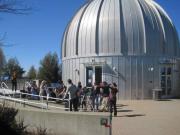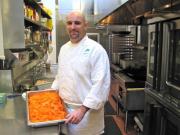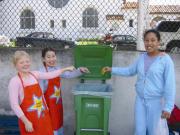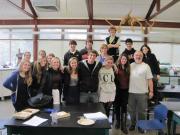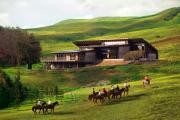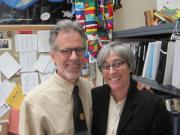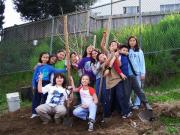Green Schools: The East Coast Again
In late March I made another trip to the East Coast in search of best practices among a dozen schools in Western Massachusetts and Connecticut, New York, and Central New Jersey. Traveling on a chilly spring week with snow still on the ground in some parts, I visited the following schools in order of their appearance: 1. Berkshire School, 2. Hotchkiss School, 3. Millbrook School, 4. New Canaan Country School, 5. Riverdale Country School, Fieldston School, and the Green Schools Alliance, 6. Princeton Academy, 7. Willow School, 8. Lawrenceville School, and 9. Princeton Day School. This trip concluded my initial round of visits on the Green Schools Express. Stay tuned for reflections on what I have learned and where I think the environmental sustainability movement is and should be headed.
1. Berkshire School: Team Green
When Mike Maher became Head of School at the Berkshire School in 2004, he brought with him a strong desire to help his new school grow in important ways, and a leadership style focused on building his team to achieve ambitious goals.  Berkshire School, founded in 1907 and today a coed boarding school of nearly 400 students from around the globe and across the country, is making bold strides as a leader in environmental sustainability having declared an ambitious goal to become carbon neutral by 2016. The Berkshire story is one led by a “team turning green.”
Berkshire School, founded in 1907 and today a coed boarding school of nearly 400 students from around the globe and across the country, is making bold strides as a leader in environmental sustainability having declared an ambitious goal to become carbon neutral by 2016. The Berkshire story is one led by a “team turning green.”
Raised in Minnesota and educated in the public schools, Maher came east to attend the University of Vermont and after graduation began run of nearly two decades as a teacher, coach and administrator at the Taft School, an independent boarding school in Connecticut.  Arriving at Berkshire, he immediately began a “broad conversation” about “where the school was going and what we could do,” and he became convinced that environmental sustainability “had to be a cornerstone.” To achieve that vision, he turned to his “team of experts” already at the school, and began to recruit new faculty who had a passion for environmental education.
Arriving at Berkshire, he immediately began a “broad conversation” about “where the school was going and what we could do,” and he became convinced that environmental sustainability “had to be a cornerstone.” To achieve that vision, he turned to his “team of experts” already at the school, and began to recruit new faculty who had a passion for environmental education.
He enlisted veteran biology teacher Frank Barros to help lead the effort. Head of the rock-climbing club and outdoor program, he focused initially on a campus recycling program that was so successful it was recognized by the National Wildlife Federation.  Then he gathered a group of students to enter the Green School Alliance’s Green Cup Challenge to reduce energy use, a competition which they won the first time they entered in good part because Barros “figured out a way to engage the kids.” When Maher invited the students to speak to the Board of Trustees, it was a “magic moment” as the school’s leadership “was inspired by what the kids did.” Rather than proceeding with an energy audit that was estimated to be quite expensive, Maher again asked Barros to engage the students in the evaluation process, and his Conservation Studies class produced a recommendation to incorporate solar energy that the school embraced. His class on Sustainability and Resource Management now regularly engages students in projects to recommend policy changes to the school’s administration.
Then he gathered a group of students to enter the Green School Alliance’s Green Cup Challenge to reduce energy use, a competition which they won the first time they entered in good part because Barros “figured out a way to engage the kids.” When Maher invited the students to speak to the Board of Trustees, it was a “magic moment” as the school’s leadership “was inspired by what the kids did.” Rather than proceeding with an energy audit that was estimated to be quite expensive, Maher again asked Barros to engage the students in the evaluation process, and his Conservation Studies class produced a recommendation to incorporate solar energy that the school embraced. His class on Sustainability and Resource Management now regularly engages students in projects to recommend policy changes to the school’s administration.
Barros now has assumed the role of Sustainability Director and runs the Sustainability Committee, which brings together key faculty and administrators to make and implement decisions with Maher’s oversight and approval when needed. A self-described “data guy” with an MFS from the Yale School of Forestry, Barros is working with a group of eight other New England boarding schools to pilot a metric adapted from the Association for the Advancement of Sustainability in Higher Education (AASHE) to create the means for individual schools to measure their performance over time and against the experience of others.
The newest member of the administrative “green team,” Wil Smith joined Berkshire in the fall of 2010 from Bowdoin College and assumed broad duties as Dean of Community and Multicultural Affairs with a special assignment to advance solar power at the school.  Raised in Florida and a Navy veteran, Smith attended Bowdoin, captained three sports, attended law school after college, and returned to his alma mater to develop their diversity initiatives. In a short time, building on the work of Frank Barros and others, he has guided the school to a power purchase agreement to install an eight-acre solar array that is estimated to produce 40% of the school’s electricity needs and to save $1.6 million over the next ten years.
Raised in Florida and a Navy veteran, Smith attended Bowdoin, captained three sports, attended law school after college, and returned to his alma mater to develop their diversity initiatives. In a short time, building on the work of Frank Barros and others, he has guided the school to a power purchase agreement to install an eight-acre solar array that is estimated to produce 40% of the school’s electricity needs and to save $1.6 million over the next ten years.
With team leadership like this, Berkshire School has made impressive strides toward sustainability. The school systematically works on goals that include education and awareness; net zero green house gas emissions through efficiency and renewable energy; a local, organic “closed loop” food system from production to dining to waste disposal; campus land preservation; and a “cradle to cradle” zero waste policy. The school’s Climate Action Plan expresses their fondest hopes for the future. We all will benefit from their aspirations.
2. Hotchkiss School: Inspiring Education for Sustainability
When Malcolm McKenzie became Head of School at Hotchkiss in 2007, he felt a powerful attraction to the “sheer magic” of the school’s setting in the rolling hills of northwest Connecticut and observes that “it’s very powerful to be surrounded by such singular beauty.” Joining this highly regarded boarding school for 600 students set on nearly 1000 acres of land, he also brought a passion for academic excellence and broad international experience gained from his childhood growing up in South Africa and his leadership of schools in Botswana and Wales.
Joining this highly regarded boarding school for 600 students set on nearly 1000 acres of land, he also brought a passion for academic excellence and broad international experience gained from his childhood growing up in South Africa and his leadership of schools in Botswana and Wales.  Now he is asking that Hotchkiss continue its century-long tradition of educating young leaders devoted to service by responding “with urgency to the clarion calls of this century’s two greatest challenges and opportunities: environmental degradation and global interconnectedness.”
Now he is asking that Hotchkiss continue its century-long tradition of educating young leaders devoted to service by responding “with urgency to the clarion calls of this century’s two greatest challenges and opportunities: environmental degradation and global interconnectedness.”
After several years of developing the school’s sustainability vision, McKenzie took important action in 2009, creating a new position of Assistant Head/Director of Environmental Initiatives. He then hired Josh Hahn to take on the leadership of sustainability at Hotchkiss.  Hahn himself brought a lifetime’s experience in environmental education to his new work. The son of a school head himself, he recalls spending almost every summer growing up at the Interlocken camp in New Hampshire where he developed a vision of the importance of “giving students direct experience in the natural world.” He received a B.A. in environmental studies from the University of Vermont, encountering great thinkers from David Orr and Amory Louvins to Bill McKibben and Paul Hawken. In the years that followed he served as education director at Shelburne Farms, was present at the start of the Island School in the Bahamas, expanded sustainability initiatives at Lawrenceville, and began a consulting business, which allowed him to visit schools across the country to promote sustainability education.
Hahn himself brought a lifetime’s experience in environmental education to his new work. The son of a school head himself, he recalls spending almost every summer growing up at the Interlocken camp in New Hampshire where he developed a vision of the importance of “giving students direct experience in the natural world.” He received a B.A. in environmental studies from the University of Vermont, encountering great thinkers from David Orr and Amory Louvins to Bill McKibben and Paul Hawken. In the years that followed he served as education director at Shelburne Farms, was present at the start of the Island School in the Bahamas, expanded sustainability initiatives at Lawrenceville, and began a consulting business, which allowed him to visit schools across the country to promote sustainability education.
Hotchkiss is taking bold steps to build on its already impressive commitment to environmental sustainability. Hahn’s charge at Hotchkiss is to integrate initiatives in the physical plant, dining hall, energy management and the newly acquired school farm. Among the school’s significant accomplishments to date are four LEED certified buildings, including two dorms, an athletic center that will soon be equipped with solar panels to heat the pool, and a fine arts and music center. Despite increasing the physical plant by 30% in the last several years there has been an overall 15% reduction in energy costs through conservation and renewable energy like the purchase of wind power to provide nearly a quarter of the school’s electrical needs. The school has also launched a new summer environmental studies program.
Among the school’s significant accomplishments to date are four LEED certified buildings, including two dorms, an athletic center that will soon be equipped with solar panels to heat the pool, and a fine arts and music center. Despite increasing the physical plant by 30% in the last several years there has been an overall 15% reduction in energy costs through conservation and renewable energy like the purchase of wind power to provide nearly a quarter of the school’s electrical needs. The school has also launched a new summer environmental studies program.
With Hahn’s leadership the school is poised to launch two major, innovative, “regenerative” efforts. After an analysis of the school’s aging, oil-fired central heating system, the administration and Board of Trustees have decided to build in the next two years a $14 million, privately-funded biomass plant that will be powered by wood-chips sourced from the local area. Estimated to save $750,000 annually and cut the school’s carbon footprint by 1/3 to 1/2, the facility is being designed to serve as a learning laboratory for students.
A second effort focuses on the recently acquired 280-acre farm located about a quarter mile south of the campus on a broad, gently sloping ridge that commands a stunning view of the surrounding hills, lakes and mountains.  Under the direction of Fine Arts Department Chair Charlie Noyes, a Hotchkiss alum and 25 year veteran teacher, the Fairfield Farms Environmental and Adventure Team (FFEAT) gives students the chance to learn the operation of a working farm. The master plan for The Hotchkiss School Farm calls for it to “serve as an authentic outdoor laboratory” by giving students a chance to learn about growing food and connect with the land. Visiting the students working the farm on a chilly spring day, I learned firsthand the impact this program will have.
Under the direction of Fine Arts Department Chair Charlie Noyes, a Hotchkiss alum and 25 year veteran teacher, the Fairfield Farms Environmental and Adventure Team (FFEAT) gives students the chance to learn the operation of a working farm. The master plan for The Hotchkiss School Farm calls for it to “serve as an authentic outdoor laboratory” by giving students a chance to learn about growing food and connect with the land. Visiting the students working the farm on a chilly spring day, I learned firsthand the impact this program will have.  As junior Hannah Teachey explained, she never had a chance to connect with nature growing up in her home in Wilmington, North Carolina, but at Hotchkiss she loves spending afternoons tending the garden, especially after rigorous study in chemistry and calculus, and she hopes to become a teacher and farmer.
As junior Hannah Teachey explained, she never had a chance to connect with nature growing up in her home in Wilmington, North Carolina, but at Hotchkiss she loves spending afternoons tending the garden, especially after rigorous study in chemistry and calculus, and she hopes to become a teacher and farmer.
Hotchkiss envisions becoming carbon neutral by 2020. With the leadership of Malcolm McKenzie and Josh Hahn, and with a team of committed students, faculty and trustees with them, they are inspiring change in a very special place.
3. Millbrook School: Progressively Sustainable
When Edward Pulling founded Millbrook School in 1931, he sought to create a boarding school that was "conservatively progressive," a place where students would be educated close to nature and where they could learn the practice of democracy and become responsible citizens while preparing for college. Raised in Britain and educated at the Gilman School and Princeton, he taught at Groton School for the legendary Endicott Peabody. He set out to find a place where his vision could flourish; he found that spot on 200 acres of rolling countryside in Millbrook, New York. Today on an 800 acre campus that is surrounded by many more acres of land help in public trust, the school has incorporated environmental sustainability as a core value to inspire its students to embrace and protect the natural world.
He set out to find a place where his vision could flourish; he found that spot on 200 acres of rolling countryside in Millbrook, New York. Today on an 800 acre campus that is surrounded by many more acres of land help in public trust, the school has incorporated environmental sustainability as a core value to inspire its students to embrace and protect the natural world.
Millbrook’s sustainability initiatives are well led by Headmaster Drew Casertano and long-time faculty member Jane Meigs. Casertano is steeped in New England independent education, having been educated and worked in “beautiful places,” from Choate to Amherst and at Loomis Chafee and The Gunnery.  He grew up on and around farms in Cheshire, Connecticut where he learned to work in the fields hoeing beans and harvesting apples. Coming to Millbrook, he discovered how “environmental elements could be incorporated in the school’s educational philosophy” and led a process to include environmental stewardship as one of Millbrook’s core values.
He grew up on and around farms in Cheshire, Connecticut where he learned to work in the fields hoeing beans and harvesting apples. Coming to Millbrook, he discovered how “environmental elements could be incorporated in the school’s educational philosophy” and led a process to include environmental stewardship as one of Millbrook’s core values.
Casertano found an important ally in Jane Meigs, who came initially to the school as the librarian when her husband, Jono Meigs, a Millbrook alumnus, was hired to direct the on-campus wildlife conservation center called the Trevor Zoo.  Meigs has fond memories of spending time outdoors with her parents and says the “natural world got into me” while hiking forests of Michigan and swimming in the lake. Educated at Oberlin, she early on embraced the modern environmental movement beginning with the first Earth Day in 1970. Over the years at Millbrook, her role has evolved to include the important work as chairperson of the Environmental Council, established in 2002 to guide the school’s initiatives and pursue annual goals for recycling, energy and resource conservation, green building practices, healthy food, and program development called Educating for Environmental Stewardship and Sustainability.
Meigs has fond memories of spending time outdoors with her parents and says the “natural world got into me” while hiking forests of Michigan and swimming in the lake. Educated at Oberlin, she early on embraced the modern environmental movement beginning with the first Earth Day in 1970. Over the years at Millbrook, her role has evolved to include the important work as chairperson of the Environmental Council, established in 2002 to guide the school’s initiatives and pursue annual goals for recycling, energy and resource conservation, green building practices, healthy food, and program development called Educating for Environmental Stewardship and Sustainability.
With a strong basis in the mission, inspired by the vision Drew Casertano and Jane Meigs have fashioned, Millbrook is engaged in a systemic effort that has moved from “what people debate to what all members of the community do.” There is ample evidence of the school’s success. Millbrook recently completed a handsome, LEED gold Math and Science Center, for example, and the Board of Trustees established a policy that any future construction must meet a minimum LEED silver standard.  Currently engaged in an energy audit, they have pursued many steps to reduce energy consumption, from switching light fixtures to reducing waste 50% through a composting program. The choices they make are filtered through the essential question: Will this decision encourage the careful stewardship of Millbrook's natural resources?
Currently engaged in an energy audit, they have pursued many steps to reduce energy consumption, from switching light fixtures to reducing waste 50% through a composting program. The choices they make are filtered through the essential question: Will this decision encourage the careful stewardship of Millbrook's natural resources?
One of Millbrook’s most distinctive programs is the wildlife conservation center called the Trevor Zoo. Under the direction since 1974 of Jono Meigs, it sits on several acres adjacent to the Math and Science Center and houses approximately 80 species and 180 animals, including seven that are endangered and are in Species Survival Plan breeding programs.  It was impressive to see firsthand how the Millbrook students have seized this opportunity to become naturalists as they worked their community service shift at the Zoo, feeding the animals, cleaning the cages, preparing reports for their other classes using the center as a place for study, and getting a briefing from Jono Meigs on their preparation to host several thousand students from schools in the surrounding region who will come on field trips in the spring.
It was impressive to see firsthand how the Millbrook students have seized this opportunity to become naturalists as they worked their community service shift at the Zoo, feeding the animals, cleaning the cages, preparing reports for their other classes using the center as a place for study, and getting a briefing from Jono Meigs on their preparation to host several thousand students from schools in the surrounding region who will come on field trips in the spring.
True to its founding progressive vision, Millbrook encourages students to take action that follows from their education and beliefs. The group called SCAPE--Students Concerned About Planet Earth--led the entire school in a campaign on behalf of the endangered red panda. Millbrook is a powerful example of education that encourages students to act on behalf of our environment.
4. New Canaan Country School: Commitment to Sustainability
For Head of School Tim Bazemore, environmental sustainability has long been a passion. He says that New Canaan Country School has made “an institutional commitment to principles of environmental, economic and human sustainability” that has been “inspired by the energy and idealism of our students, led by dedicated teachers and staff, and endorsed by the Board.”  This commitment was clear the day I visited NCCS, a K-9, coed independent school perched on 75 acres of beautiful, wooded land atop Ponus Ridge in Western Connecticut.
This commitment was clear the day I visited NCCS, a K-9, coed independent school perched on 75 acres of beautiful, wooded land atop Ponus Ridge in Western Connecticut.
Bazemore’s team-centered leadership of this effort was evident as I was greeted upon my arrival by a large group of the school’s Environmental Committee, including its co-chair and Environmental Coordinator Dave Stoeller; Tech Department member and coordinator of the trails and outdoors program Matt Taylor; Middle School science teacher Sanjiv Naliakal; Environmental Committee Co-Chair Paul Nye, who leads the Clean Plate program and member of the Board’s Sustainability Task Force; Facilities Manager John Murphy; and Business Manager John Ziac, who is in charge of the sustainable food program offered by Flick Independent Schools.  Over a tasty lunch and surrounded by the joyful voices of the students, we discussed how NCCS embraced sustainability these last ten years.
Over a tasty lunch and surrounded by the joyful voices of the students, we discussed how NCCS embraced sustainability these last ten years.
In 2002 Bazemore joined other like-minded school heads and thought leaders for an environmental summit held at the new Willow School in New Jersey led by NAIS vice-president Claudia Gallant. From this gathering came the NAIS Sustainability Institute and the theme for the national conference in 2005. Inspired by the decision of NAIS to promote environmental sustainability, Bazemore worked to frame the process to transform his school. The Environmental Policy Statement in 2004 endorsed by the Board declared, “We live in a world of great natural beauty and finite resources. As an institution we need to operate as good stewards of our campus and this planet….In recognition of this, the Board of Trustees encourages the administration, faculty and staff of NCCS to be mindful of environmental issues in curriculum design, community service, plant operations and facilities improvements.” Three years later the Board revised the mission statement to state: “The school works in partnership with families to teach personal, social and environmental responsibility and to create a community that honors diversity and our common humanity.” The Environmental Committee, which seeks “to educate and empower the students we serve and to prepare them to be stewards of the natural world,” is charged with monitoring the school’s annual progress and benchmarking NCCS’s performance against peer schools. This culture of shared vision and collaborative leadership has led to significant accomplishments.
Greening the campus architect became a special project for local architect Jim Rogers, an NCCS alumnus who also chaired the Board at Exeter Academy and spearheaded their sustainability initiative at the same time.  Rogers designed the renovation and addition to the Upper School Stevens building, which earned LEED silver recognition when it opened in 2007 and which set the standard for all future construction, which must incorporate LEED principles. The campus operations have been revamped through ambitious recycling, energy retrofits, careful removal of hazardous wastes, use of green cleaning products, and a new food service.
Rogers designed the renovation and addition to the Upper School Stevens building, which earned LEED silver recognition when it opened in 2007 and which set the standard for all future construction, which must incorporate LEED principles. The campus operations have been revamped through ambitious recycling, energy retrofits, careful removal of hazardous wastes, use of green cleaning products, and a new food service.  A new project will install boardwalks to expand the school’s campus trail system to incorporate the nearby vernal pond and wetlands, all of which is available for use by the larger community.
A new project will install boardwalks to expand the school’s campus trail system to incorporate the nearby vernal pond and wetlands, all of which is available for use by the larger community.
With a mission focused on student-centered learning, environmental sustainability has been woven into the curriculum. I joined First Grade teacher Chantal Detlefs, who developed a unit in collaboration with the Connecticut River Salmon Association to hatch and raise salmon in the classroom for later release into the streams in an effort to save this endangered species.  Lower School art teacher Mark Macrides showed his kindergarten projects done with recycled materials. And I joined an assembly featuring a wolf brought in to teach the Upper School students about efforts to reintroduce this animal into the country.
Lower School art teacher Mark Macrides showed his kindergarten projects done with recycled materials. And I joined an assembly featuring a wolf brought in to teach the Upper School students about efforts to reintroduce this animal into the country.
NCCS has embraced the vision of the 1987 Rutland Commission and is developing a program that integrates environmental, economic and human sustainability. As Tim Bazemore observes, “we believe our students are capable of grasping more complex understandings of sustainability.” He and his school team are doing a very fine job of preparing the next generation to take leadership in this vital area.
5. Riverdale, Fieldston & The Green Schools Alliance: Mobilizing for Change
When I met Peg Watson, the energetic New York City architect and mother who joined with others to found the Green Schools Alliance, on the campus of the Riverdale Country School in the Bronx, I knew I was in for a whirlwind day.  We had been in animated conversation throughout the year discussing the ways the GSA could extend its reach geographically and programmatically beyond the 37 states and 10 countries where it is now a presence. Together we visited two Charter Member GSA schools and saw firsthand the impact of GSA’s initiative to battle climate change.
We had been in animated conversation throughout the year discussing the ways the GSA could extend its reach geographically and programmatically beyond the 37 states and 10 countries where it is now a presence. Together we visited two Charter Member GSA schools and saw firsthand the impact of GSA’s initiative to battle climate change.
When Peg Watson’s son was a first grader, he asked her what could be done about global warming. She decided to take action at his school, Allen-Stevenson, where she organized a conference of forty-six schools in response to Mayor Bloomberg’s 2007 challenge that New York reduce carbon emissions 30% by 2030. The GSA is an example of “schools guiding schools,” and the organization now includes nearly 300 independent schools from across the country and a total of 1200 with the inclusion of the New York City schools. Each participating school pledges to reduce its carbon emissions, and those that set a goal of a 30% reduction in five years and carbon neutrality by 2020 are Climate Champions. (The GSA website provides detailed information about the organization.)
To promote the cause, the GSA incorporated the Green Cup Challenge, created by a group of New England boarding schools who are Charter Members, to inspire student-led efforts to reduce energy use. The GSA also promotes resource fairs and hosts the annual Sc3 (Global Climate and Conservation Corps) Congress in June with the U.S. Fish and Wildlife Service to train student leaders. The GSA is another testament of the power one individual citizen, working with many others, can have to motivate change.
We met David Patnaude, Director of Plant and Sustainability, who has been leading the efficiency effort for the past four years at the Riverdale County School, a K-12 coed independent school of 1050 students on 28 acres.  When he arrived at Riverdale from sustainability work at Harvard and Tufts, Patnaude felt as if he had “parachuted into the 1980s,” and he set an ambitious goal to meet the GSA challenge and secure a 30% greenhouse gas reduction by 2013. A trained engineer, he articulated a number of principles that guide his work: “You can’t manage what you don’t measure,” “lowest cost is necessarily not the best choice in the long run,” “use life-cycle analysis to measure long-term financial impact,” and “value is key.” Based on a student-led study of the school’s carbon footprint, Patnaude says Riverdale cut its emissions by approximately 20% in the 2008-09 school year alone.
When he arrived at Riverdale from sustainability work at Harvard and Tufts, Patnaude felt as if he had “parachuted into the 1980s,” and he set an ambitious goal to meet the GSA challenge and secure a 30% greenhouse gas reduction by 2013. A trained engineer, he articulated a number of principles that guide his work: “You can’t manage what you don’t measure,” “lowest cost is necessarily not the best choice in the long run,” “use life-cycle analysis to measure long-term financial impact,” and “value is key.” Based on a student-led study of the school’s carbon footprint, Patnaude says Riverdale cut its emissions by approximately 20% in the 2008-09 school year alone.  In our tour we saw some of the reasons for the dramatic change: a solar array on the new Jeslo theater building, energy controls in the Student Center that control the vending machines, the new synthetic field, a no tray cafeteria to eliminate washing costs along with the associated additional water, detergent and energy, and a policy directed at “turning off the lights” when they are not needed. Taking a holistic approach, he is driving systemic change, as he invoked in a recent message to the community: "I encourage all interested students, faculty, parents and administrators to work with the Sustainability Committee to continue to challenge the school to find ways to reduce our carbon footprint.
In our tour we saw some of the reasons for the dramatic change: a solar array on the new Jeslo theater building, energy controls in the Student Center that control the vending machines, the new synthetic field, a no tray cafeteria to eliminate washing costs along with the associated additional water, detergent and energy, and a policy directed at “turning off the lights” when they are not needed. Taking a holistic approach, he is driving systemic change, as he invoked in a recent message to the community: "I encourage all interested students, faculty, parents and administrators to work with the Sustainability Committee to continue to challenge the school to find ways to reduce our carbon footprint.  While it is more difficult to measure, we can continue to lower our overall carbon footprint by continuing to lighten the color of our roofs, not wasting food, eating more locally-produced foods, car-pooling, reducing, recycling and re-using, thinking about variables such as packaging and what products are made of when making consumer purchases, shopping within a 500 mile radius, etc. In a more concrete way, we can continue to do things such as installing thermal-solar-hot-water panels and utilizing wind energy."
While it is more difficult to measure, we can continue to lower our overall carbon footprint by continuing to lighten the color of our roofs, not wasting food, eating more locally-produced foods, car-pooling, reducing, recycling and re-using, thinking about variables such as packaging and what products are made of when making consumer purchases, shopping within a 500 mile radius, etc. In a more concrete way, we can continue to do things such as installing thermal-solar-hot-water panels and utilizing wind energy."
Nearby we visited the Middle-Upper School campus of the Ethical Culture Fieldston School (ECF), another independent K-12 school in the Bronx for 1670 students on an 18-acre.  Since 1975 Director of Facilities Gene Kivlan has been in charge of plant operations at the school, and he was especially proud to show us the 2008 LEED silver Middle School building, the first new LEED certified school building in New York City. The building exhibits the features of environmental design, including operable windows, motion operated sink spigots, low flow toilets, waterless urinals, and certified wood.
Since 1975 Director of Facilities Gene Kivlan has been in charge of plant operations at the school, and he was especially proud to show us the 2008 LEED silver Middle School building, the first new LEED certified school building in New York City. The building exhibits the features of environmental design, including operable windows, motion operated sink spigots, low flow toilets, waterless urinals, and certified wood.  The “crown jewel” of the building, two green roofs covered with drought-tolerant, native plants and utilizing a water catchment system that captures rainwater in several large cisterns. The roofs were designed with significant input from the science department for use as teaching tools.
The “crown jewel” of the building, two green roofs covered with drought-tolerant, native plants and utilizing a water catchment system that captures rainwater in several large cisterns. The roofs were designed with significant input from the science department for use as teaching tools.  The view from the top commands a view of the handsome campus, complete with a new artificial turf athletic field. The Middle School building represents the culmination of more than a decade of sustainability work at ECF which, like their neighbor to the north, was a Charter Member of the Green Schools Alliance. As he observed, ECF is committed to making sustainable choices for the long-term, and they are clearly leading the way.
The view from the top commands a view of the handsome campus, complete with a new artificial turf athletic field. The Middle School building represents the culmination of more than a decade of sustainability work at ECF which, like their neighbor to the north, was a Charter Member of the Green Schools Alliance. As he observed, ECF is committed to making sustainable choices for the long-term, and they are clearly leading the way.
6. Princeton Academy: Growing Greener
Founded just twelve years ago, Princeton Academy of the Sacred Heart, an independent Catholic lower and middle school for 200 boys is using its mission to “educate children to become leaders of a just society” to develop a vision of environmental sustainability. The school has been working on projects from recycling to campus renovation. And their headmaster and faculty are beginning to organize a more systematic approach to becoming “green.”
Headmaster Olen Kalkus developed his vision for the school from his significant global experience.  He lived in communities around the world from Chicago to Germany and from Morocco to the Czech Republic, where he saw first hand the environmental degradation that resulted from the Soviet occupation of Europe. He credits his immigrant parents for inculcating a “frugal sense that we should live with less and focus on quality” and frequent visit to Colorado for his love of nature.
He lived in communities around the world from Chicago to Germany and from Morocco to the Czech Republic, where he saw first hand the environmental degradation that resulted from the Soviet occupation of Europe. He credits his immigrant parents for inculcating a “frugal sense that we should live with less and focus on quality” and frequent visit to Colorado for his love of nature.
At Princeton Academy that vision is beginning to bear fruit, and the Board of Trustees has just approved a new sustainability policy. As we toured the campus, he proudly explained the genesis of the newly constructed Blue & Green House, a geodesic dome greenhouse designed to operate without producing any greenhouse emissions and that serves as an indoor garden and science lab for students.  He notes that the school colors, blue and green, “were chosen to reflect the colors of a healthy planet Earth, as seen from space…from our earliest years we have always looked for ways to steward the environment.” The school has completed a number of campus projects to implement this vision, including reduced outdoor lighting to maintain a “dark-sky environment,” natural meadows that ring the central campus. The recently completed Athletic and Convocation Center was sited to face north and build into the ground to reduce requirement for heating and air conditioning and artificial lighting.
He notes that the school colors, blue and green, “were chosen to reflect the colors of a healthy planet Earth, as seen from space…from our earliest years we have always looked for ways to steward the environment.” The school has completed a number of campus projects to implement this vision, including reduced outdoor lighting to maintain a “dark-sky environment,” natural meadows that ring the central campus. The recently completed Athletic and Convocation Center was sited to face north and build into the ground to reduce requirement for heating and air conditioning and artificial lighting.
The school occupies a Convent originally built in 1960 and anticipates incorporating green building principles in its renovation. Recently, the Academy created the William E. Simon Chapel Library, repurposed from its original use.
The school is beginning organize the efforts of faculty who have been leading many sustainability initiatives. I met with a dedicated group—Reading Specialist Sheri Verdu, Lower School Head Suzanne Kazi, Middle School Head Kathy Humora, English teacher Holly Weise, and Science teacher Brent Deisha—and learned about their efforts to promote the Three Rs to reduce, reuse, and recycle, a worm-composting project, and the school’s recent participation in the Green School Alliance Green Cup Challenge. The school regularly participates in conferences sponsored by OAISIS, which organizes environmental initiatives among 17 local independent schools. From my sister-in-law Ann Chapman, who has taught English at the school for many years, I know that there is a strong environmental theme in the literature the boys read.
The school regularly participates in conferences sponsored by OAISIS, which organizes environmental initiatives among 17 local independent schools. From my sister-in-law Ann Chapman, who has taught English at the school for many years, I know that there is a strong environmental theme in the literature the boys read.
It was especially fun to meet with student members of the school’s Nature Club, young men who told me of their love for the outdoors gained while hiking, fishing and camping with family. 
 After teaching a brief lesson on Greening Your School to the Seventh Grade Science Class, I heard directly from the students their enthusiasm for environmental studies such as the transect evaluation of the campus and off-campus activities like the Lake Carnegie clean up and a recent 5K run.
After teaching a brief lesson on Greening Your School to the Seventh Grade Science Class, I heard directly from the students their enthusiasm for environmental studies such as the transect evaluation of the campus and off-campus activities like the Lake Carnegie clean up and a recent 5K run.
Princeton Academy is poised to move more boldly into the field of environmental sustainability with a more systematic approach. They surely have the team to take them there.
7. Willow School: Founded to Be Green
When Mark and Gretchen Biedron decided to found a new independent school in 2000 in Gladstone, New Jersey, they envisioned a place where children would be able to be educated close to nature.  Each had grown up and attended independent schools in central New Jersey before going to college. After Pingry School Mark Biedron attended the University of Vermont; Gretchen went to Far Hills Country Day and Peck, before attending Hotchkiss and then Brown. Returning to their roots, they created a K-8 elementary school on 34 acres that is growing to its full projected enrollment of 252 students.
Each had grown up and attended independent schools in central New Jersey before going to college. After Pingry School Mark Biedron attended the University of Vermont; Gretchen went to Far Hills Country Day and Peck, before attending Hotchkiss and then Brown. Returning to their roots, they created a K-8 elementary school on 34 acres that is growing to its full projected enrollment of 252 students.
For Mark Biedron, there were three pillars to the mission of the new school. It would be a place where language fluency would connect people, kids would experience the joy of learning, and the place would nurture ethical relationships. With a professional background in his family’s business manufacturing low VOC paints, he developed a view that “buildings need to be part of the natural world.”  Eventually he started a new company that “specializes in green construction and historic renovation using salvaged and recycled materials.” Convinced that sustainable architecture and building were on the “cutting edge,” he and his wife envisioned a school that would embody environmentally sustainable practices, in the construction, operation and educational program.
Eventually he started a new company that “specializes in green construction and historic renovation using salvaged and recycled materials.” Convinced that sustainable architecture and building were on the “cutting edge,” he and his wife envisioned a school that would embody environmentally sustainable practices, in the construction, operation and educational program.
Visiting the school during spring break, it was clear that the entire campus had been constructed to achieve a build environment that is “close to nature.” The LEED certified elementary building is sited to take advantage of the southern warming sun for the hallways and orients all the classrooms to the north so that they are filled with natural light and access to the outdoors. The LEED Platinum Middle School has been created within the frame of an old barn that was relocated to the site. And the administration building occupies the original farmhouse. Close by sits a large organic garden and throughout the adjacent woods one can see forts the children have created in moments of free playtime.
Four years after the school opened in 2002, Willow recruited an experienced educator to lead the process of developing the educational program.  Head of School Kate Burke Walsh herself remembers growing up in Potomac, Maryland with “unfettered days” where she could play in the nearby fields and creeks. Living in Vermont after her graduation from American University, she began working at a day care center sponsored by Antioch University of New England, an experience that captured her imagination and led her to get an M.A. in early childhood education. Years serving as a teacher and administrator at the Beauvoir School in Washington, time leading professional development programs in Eastern Europe, and a decade as the administrative head of the French International School in Bethesda, readied her for the challenge.
Head of School Kate Burke Walsh herself remembers growing up in Potomac, Maryland with “unfettered days” where she could play in the nearby fields and creeks. Living in Vermont after her graduation from American University, she began working at a day care center sponsored by Antioch University of New England, an experience that captured her imagination and led her to get an M.A. in early childhood education. Years serving as a teacher and administrator at the Beauvoir School in Washington, time leading professional development programs in Eastern Europe, and a decade as the administrative head of the French International School in Bethesda, readied her for the challenge.
As Walsh observes, the school is “an intentionally environmental community, designed to address the way we interact with our human and natural resources,” a place where “individuals first learn to take responsibility for themselves, and…come to see the myriad ways in which they are responsible not only for themselves but for their environment as well.” She recounted how the curriculum often develops from students’ questions. “Where is away?” wondered a kindergarten reflecting on the destination for garbage that gets tossed out.  That led to a unit that took the five year olds to the sanitation center, and a scientific inquiry measuring how long it took plastic and an apple core to decompose in the nearby woods. Relying on the work of Dewey, Piaget and Kohlberg, Walsh and her faculty seek to nurture young children who “know who they are and know their capacity to effect change.”
That led to a unit that took the five year olds to the sanitation center, and a scientific inquiry measuring how long it took plastic and an apple core to decompose in the nearby woods. Relying on the work of Dewey, Piaget and Kohlberg, Walsh and her faculty seek to nurture young children who “know who they are and know their capacity to effect change.”
According to Kate Walsh, the Willow School is asking the question, “What are we doing for the greater good?” By building a school that is attuned to nature, Willow is providing us a fine example of how academic excellence and environmental education go hand in hand.
8. Lawrenceville School: An Ethic of Stewardship
The roots of the current Green Campus Initiative grow deep at Lawrenceville, a boarding and day high school for 800 students located just south of Princeton University in gentle New Jersey countryside near farmland and woods on a campus that was designed by renowned landscape  architect Frederick Law Olmsted. The legacy of Aldo Leopold, who graduated from Lawrenceville in 1905 and is acknowledged as one of the founders of the modern environmental movement, helped inspire Headmaster Liz Duffy to establish sustainability as one of her top priorities when she came to the school in 2003. Under her direction Lawrenceville has undertaken “holistic” and systemic change to become a leader in the field of environmental sustainability.
architect Frederick Law Olmsted. The legacy of Aldo Leopold, who graduated from Lawrenceville in 1905 and is acknowledged as one of the founders of the modern environmental movement, helped inspire Headmaster Liz Duffy to establish sustainability as one of her top priorities when she came to the school in 2003. Under her direction Lawrenceville has undertaken “holistic” and systemic change to become a leader in the field of environmental sustainability.
For Liz Duffy, sustaining the planet is “the civil rights issue for this generation of young people,” and she brings skill and vision to framing her school’s role in developing their leadership.  A molecular biologist with a degree from Princeton, she headed the university’s community service program after graduation before heading to Stanford for her M.B.A. When she became Headmaster she convened a “charrette” with 65 student, faculty, administrative, alumni and trustee members of the Lawrenceville community to craft a vision for sustainability focused on water, waste, energy, transportation and program. The creation of a Board committee on sustainability “brought capacity,” and she began to organize a team to lead the effort. Participating in an NAIS panel on best leadership practices several year later, she offered these important lessons on how to green a school: “Find passionate leaders within your school community….Find ways to connect those leaders and give them opportunities to make things happen….Embed your sustainability efforts in the school structure, through a designated position, a trustee committee, or a student council, and….Involve students; they're our biggest legacy.”
A molecular biologist with a degree from Princeton, she headed the university’s community service program after graduation before heading to Stanford for her M.B.A. When she became Headmaster she convened a “charrette” with 65 student, faculty, administrative, alumni and trustee members of the Lawrenceville community to craft a vision for sustainability focused on water, waste, energy, transportation and program. The creation of a Board committee on sustainability “brought capacity,” and she began to organize a team to lead the effort. Participating in an NAIS panel on best leadership practices several year later, she offered these important lessons on how to green a school: “Find passionate leaders within your school community….Find ways to connect those leaders and give them opportunities to make things happen….Embed your sustainability efforts in the school structure, through a designated position, a trustee committee, or a student council, and….Involve students; they're our biggest legacy.”
Duffy has put principle into practice with an impressive team of leaders, including CFO/COO Wes Brooks, Dean of the Faculty Kevin Mattingly, Director of Dining Services Gary Giberson, and Sustainability Coordinator Sam Kosoff. Together they are promoting dramatic initiatives in the school’s Green Campus Initiative.  For alumnus Wes Brooks, managing the school is a labor of love, stemming from fond memories of his student years and the excellent education his children received at the school. A banker working world wide over 30 years, he brought financial acumen and a focus on systems to his work. Perhaps the most dramatic achievement in his administration has been the decision to sign a six-megawatt solar power purchase agreement this year with Turtle Energy. The facility, which will be built on 30 acres of the campus and will be one of the largest solar arrays at an educational institution, promises to provide about 90% of the schools electricity and save the school an average of $400, 000 a year over 20 years.
For alumnus Wes Brooks, managing the school is a labor of love, stemming from fond memories of his student years and the excellent education his children received at the school. A banker working world wide over 30 years, he brought financial acumen and a focus on systems to his work. Perhaps the most dramatic achievement in his administration has been the decision to sign a six-megawatt solar power purchase agreement this year with Turtle Energy. The facility, which will be built on 30 acres of the campus and will be one of the largest solar arrays at an educational institution, promises to provide about 90% of the schools electricity and save the school an average of $400, 000 a year over 20 years.
Long time science teacher and former department chair, Kevin Mattingly, gained a love of the outdoors growing up and camping in his native Indiana and eventually earned a Ph.D. in ecology and evolutionary biology.  He became a founding member of the Mountain School in Vermont and helped launch Lawrenceville’s parallel venture called the Island School. “We have to teach our students to read the landscape as a text,” he says, and “we have to develop systems and constraints to ensure the sustainability of our environment.” Now he is working to “infuse environmental literacy in the curriculum.” The science department, which Mattingly formerly led and is now chaired by Reuwai Hanewald, has crafted a new Science 9 course to address three essential questions: “What lives where and why? What keeps us alive? Is biology destiny.” Increasingly, the department is bringing a place-based, real-world problem solving focus to the curriculum, from the introductory course through upper division electives and field courses from the Galapagos to the Amazon.
He became a founding member of the Mountain School in Vermont and helped launch Lawrenceville’s parallel venture called the Island School. “We have to teach our students to read the landscape as a text,” he says, and “we have to develop systems and constraints to ensure the sustainability of our environment.” Now he is working to “infuse environmental literacy in the curriculum.” The science department, which Mattingly formerly led and is now chaired by Reuwai Hanewald, has crafted a new Science 9 course to address three essential questions: “What lives where and why? What keeps us alive? Is biology destiny.” Increasingly, the department is bringing a place-based, real-world problem solving focus to the curriculum, from the introductory course through upper division electives and field courses from the Galapagos to the Amazon.
Food has become a central part of the larger environmental educational program at Lawrenceville with the leadership of Executive Chef Gary Giberson.  Participating in the charrette in 2003, he had a realization that his operation was generating a great deal of waste, and over the years he has incorporated leading-edge technologies from on-campus composting systems to student-designed Zero Waste Zone recycling systems in the dining hall. Creating his own food service company, he has specialized in sourcing local, sustainable food. Honored at the White House for his leadership, Giberson was just featured in an article in the Huffington Post highlighting the dramatic changes at Lawrenceville.
Participating in the charrette in 2003, he had a realization that his operation was generating a great deal of waste, and over the years he has incorporated leading-edge technologies from on-campus composting systems to student-designed Zero Waste Zone recycling systems in the dining hall. Creating his own food service company, he has specialized in sourcing local, sustainable food. Honored at the White House for his leadership, Giberson was just featured in an article in the Huffington Post highlighting the dramatic changes at Lawrenceville.
To ensure the integration of all these efforts, Lawrenceville created a dedicated position for Director of Sustainability, which is now held by Sam Kosoff.  An alumnus himself, Kosoff taught at Lawrenceville for five years after graduating from Hamilton and then served as associate director of the Island School. Lawrenceville lured him back after a stint teaching at public and private schools in Maryland and New Jersey. With a broad portfolio that ranges from staffing the Board’s Sustainability Committee to figuring our how to integrate the school’s organic garden into the curriculum to developing metrics to measure and benchmark progress, Kosoff observes that his challenge is how to “sustain sustainability” at the school. Lawrenceville is in the vanguard among our nation’s schools pursuing environmental sustainability. We will all benefit from their leadership.
An alumnus himself, Kosoff taught at Lawrenceville for five years after graduating from Hamilton and then served as associate director of the Island School. Lawrenceville lured him back after a stint teaching at public and private schools in Maryland and New Jersey. With a broad portfolio that ranges from staffing the Board’s Sustainability Committee to figuring our how to integrate the school’s organic garden into the curriculum to developing metrics to measure and benchmark progress, Kosoff observes that his challenge is how to “sustain sustainability” at the school. Lawrenceville is in the vanguard among our nation’s schools pursuing environmental sustainability. We will all benefit from their leadership.
9. Princeton Day School: A Green Imperative
While traveling throughout the East this year in search of best practices in environmental education, many people mentioned to me the impressive work under way Princeton Day School led by Liz Cutler, the Sustainability Coordinator.  Located on a beautiful campus of over 100 acres that includes woods, streams and fields, Princeton Day School is a Pre-K through 12 independent school for 910 students whose pursuit of academic excellence is “grounded in respect for others....stewardship, community service, and the celebration of diversity.” “A steward is a keeper or caretaker,” the school declares, “one who recognizes that his or her own well-being is strengthened by service to others and to the community…” It is this spirit of service that imbues the commitment to the environment I observed in my day at the school.
Located on a beautiful campus of over 100 acres that includes woods, streams and fields, Princeton Day School is a Pre-K through 12 independent school for 910 students whose pursuit of academic excellence is “grounded in respect for others....stewardship, community service, and the celebration of diversity.” “A steward is a keeper or caretaker,” the school declares, “one who recognizes that his or her own well-being is strengthened by service to others and to the community…” It is this spirit of service that imbues the commitment to the environment I observed in my day at the school.
For Liz Cutler, a member of the English faculty for 26 years, environmental sustainability is “a moral issue, a civil rights issue, a matter of providing justice to the earth.”  Raised in Chicago, she relished the time she spent in the summers in a small village on the Indiana-Michigan border close to the lake and the white sand beaches. Those moments grounded her formal educational experience over the years, at a Jewish elementary day school, the Latin School, Duke University, and her graduate work at Princeton in comparative literature.
Raised in Chicago, she relished the time she spent in the summers in a small village on the Indiana-Michigan border close to the lake and the white sand beaches. Those moments grounded her formal educational experience over the years, at a Jewish elementary day school, the Latin School, Duke University, and her graduate work at Princeton in comparative literature.
As the school’s Sustainability Director, Cutler seems to be engaged in every aspect of the school’s environmental mission to promote efficient facilities, informed community behavior, and a broad educational program.  As she observes, “Princeton Day School is striving to raise students whose values lead them to understand the consequences of their actions and who know how to make choices with a long-term vision."
As she observes, “Princeton Day School is striving to raise students whose values lead them to understand the consequences of their actions and who know how to make choices with a long-term vision."
Touring the school, I saw the mark of environmental consciousness everywhere. The school’s large organic garden was fashioned several years ago by a group of student and parent volunteers, and the faculty use it to amplify the curriculum and supply the cafeteria with fresh produce. Attention to energy efficiency was apparent in everything from special sensors installed throughout to control lighting to CO2 monitors in the theater to regulate fresh air, and the school won the Green Cup Challenge in 2009 in part by making February Low Impact Month.  The food program is managed by Joe Carratura and Brian Mochnal from FLIK, who take seriously their role to educate the community about nutritious eating habits. The cafeteria has embraced countless operational efficiencies, as well, from removing virtually all disposable containers to a composting program that has saved 40,000 lbs of waste.
The food program is managed by Joe Carratura and Brian Mochnal from FLIK, who take seriously their role to educate the community about nutritious eating habits. The cafeteria has embraced countless operational efficiencies, as well, from removing virtually all disposable containers to a composting program that has saved 40,000 lbs of waste.
Dining with members of the Upper School environmental club, EnAct, I could see the impact of the school’s desire to develop environmental stewards. Many members spoke of their love of nature gained from hiking and gardening and Liz Cutler’s course on Literature and Nature.  The club recently decided to ask each advising group to take responsibility periodically for running the compositing program.
The club recently decided to ask each advising group to take responsibility periodically for running the compositing program.
With the leadership of Liz Cutler and her Sustainability Committee, Princeton Day School is developing a broad, educational program in environmental education with a goal to “nurture a culture of environmental stewardship.” The school’s website offers many resources in the areas of facilities, behavior, and curriculum and frequently invites readers to consider “ways you can help.” Liz Cutler also directs OASIS program that provides a professional development forum for 19 area independent schools. In the past four years OASIS has offered gatherings with Jamie Cloud of the Cloud Institute, Willow School founder Mark Beidron, trustees from Sidwell Friends who helped create their LEED Platinum Middle School building, and most recently Leith Sharp, best known for greening Harvard.
Now the students are taking the lead in environmental education. The Upper School environmental club, EnAct, is sponsoring a high school eco-conference this April, “Our Future, Our Challenge,” that is bringing an impressive array of speakers including Emily Carter, Founding Director of the Andlinger Center or Energy and the Environment at Princeton University, Robert Socolow, Co-Director Princeton University's Carbon Mitigation Initiative, and Lyle Rawlings, President of the Mid-Atlantic Solar Energy Industries Association. With initiatives like these, Princeton Day School is surely making a significant impact in developing environmental leaders for tomorrow.
